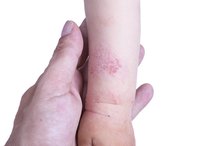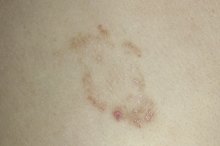Causes of a Rash on the Hands of a Child
It’s impossible to monitor every single item an inquisitive child chooses to touch. Unfortunately concerns regarding safety may arise when a child suddenly exhibits a rash on her hands. There are many different factors that contribute to a hand rash, but some causes of hand rash in children are more common than others. Knowledge of some common causes of hand rash will help guardians and caregivers make prudent decisions regarding how to respond to such symptoms.
Ringworm
Tinea is a form of fungus that commonly causes a red, itchy raised patch to grow on the skin. Children can be infected with the fungus by touching another person or animal that has the infection or by contact with contaminated surfaces in locker rooms or other humid locales. Ringworm can cause infection of the fingernails, causing them to become thick, brittle and discolored. This infection is easily curable via the use of antifungal medications prescribed by a doctor, according to KidsHealth 24.
- Tinea is a form of fungus that commonly causes a red, itchy raised patch to grow on the skin.
- Children can be infected with the fungus by touching another person or animal that has the infection or by contact with contaminated surfaces in locker rooms or other humid locales.
Irritant Contact Dermatitis
The Skin on My Child's Hands Is Peeling
Learn More
Some substances can cause rashes due to their ability to irritate the skin surface rather than due to an immunological response. Irritant contact dermatitis occurs when chemical or physical agents damage skin cells at a rate that is more rapid than the body’s ability to fix the damage. A child who comes into contact with soaps, solvents or adhesives that injure the skin may exhibit the signs of contact dermatitis on the hands.
DermNet NZ explains that exposure to an irritant of this sort will typically cause a well-demarcated area of damage, accompanied by blistering, itching pain or swelling.
- Some substances can cause rashes due to their ability to irritate the skin surface rather than due to an immunological response.
- Irritant contact dermatitis occurs when chemical or physical agents damage skin cells at a rate that is more rapid than the body’s ability to fix the damage.
Scabies
Scabies is another contagious conditions that can cause rashes on a child’s hands. This disease is spread through skin contact that transfers tiny mites from person to person. Crowded conditions such as schools can increase a child’s chances of exposure to scabies.
The mites burrow under the skin and lay eggs, causing lines to appear on the skin’s surface, sometimes along with a bumpy red rash. It commonly appears on the hands between the fingers and on the inner wrists. Scratching of this rash should be discouraged, as it can lead to bacterial infections such as impetigo, warns KidsHealth 24.
- Scabies is another contagious conditions that can cause rashes on a child’s hands.
Allergic Contact Dermatitis
Causes of Ringworm in the Genital Area
Learn More
Poison ivy is one of many possible substances that can cause allergic skin reactions in those that are allergically sensitive to them. Allergic contact dermatitis occurs when a person’s skin comes in contact with a substance that the immune system misidentifies as a physical threat. In response, the body mounts a defensive reaction to the harmless substance, flooding the area with histamines and white blood cells.
Allergens vary from person to person. Though many people experience an allergic hypersensitivity to poison ivy, a child’s allergic contact dermatitis may result from touching something that is less commonly an allergen.
- Poison ivy is one of many possible substances that can cause allergic skin reactions in those that are allergically sensitive to them.
- Though many people experience an allergic hypersensitivity to poison ivy, a child’s allergic contact dermatitis may result from touching something that is less commonly an allergen.
Related Articles
References
- MayoClinic.com: Poison Ivy Rash
- KidsHealth: Scabies
- DermNet NZ: Hand Dermatitis
- KidsHealth: Impetigo
- Usatine RP, Riojas M. Diagnosis and management of contact dermatitis. Am Fam Physician. 2010;82(3):249-55.
- American Academy of Dermatology Association. CONTACT DERMATITIS: SIGNS AND SYMPTOMS
- Cleveland Clinic. Contact Dermatitis
- Veverka KK, Hall MR, Yiannias JA, et al. Trends in Patch Testing With the Mayo Clinic Standard Series, 2011-2015. Dermatitis. 2018;29(6):310-315. doi:10.1097/DER.0000000000000411
- Pacheco KA. Occupational dermatitis: How to identify the exposures, make the diagnosis, and treat the disease. Ann Allergy Asthma Immunol. 2018;120(6):583-591. doi:10.1016/j.anai.2018.04.013
- American Academy of Dermatology Association. How dermatologist treat contact dermatitis
- Contact Dermatitis. Medline Plus.
- Katta R, Schlichte M. Diet and dermatitis: Food triggers. J Clin Aesthet Dermatol. March 2014;30–36.
- Nguyen JC, Chesnut G, et al. Allergic contact dermatitis caused by lanolin (wool) alcohol contained in an emollient in three postsurgical patients. J Am Acad Dermatol. 2010;62:1064–5.
- Saary J, Qureshi R. A systematic review of contact dermatitis treatment and prevention. J Am Acad Dermatol. 2005;53:845–55.
- Wentworth AB, Yiannias JA, et at. Trends in patch testing, J Am Acad Dermatol. 2014;70:269–75.
Writer Bio
For 15 years, Charis Grey's award-winning work has appeared in film, television, newspapers, magazines and on the Internet. She has worked as a story editor on the CBS drama "Flashpoint" and her work appears bimonthly in "The Driver Magazine." She has a Bachelor of Science in biology and a doctorate in chiropractic medicine from Palmer College.









